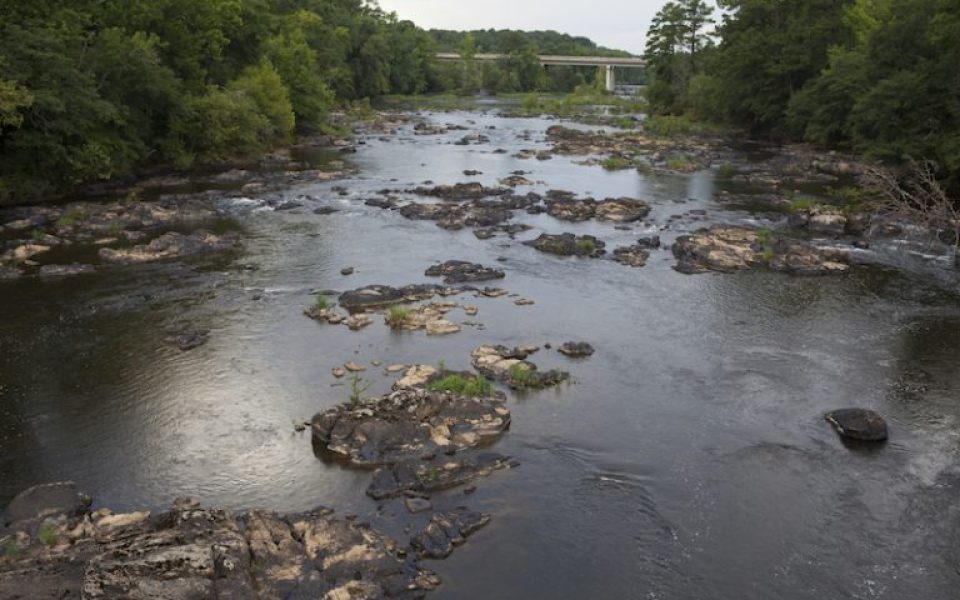by Lisa Sorg for NC Policy Watch
This article was initially published by NC Policy Watch on Nov. 16.
Featured photo: The Haw River, as viewed from the Bynum bridge. The river has been contaminated with 1,4-Dioxane; sources include the City of Greensboro, which is upstream. (photo by Lisa Sorg for NC Policy Watch)
Just days ago, Pittsboro officials said they considered the town “lucky,” thinking a slug of 1,4-Dioxane from the City of Greensboro had bypassed its water intake on the Haw River. But new test results today have prompted town staff to say they are “concerned by the uptick in concentration in in raw water samples.”
Those samples of untreated water from Nov. 12 show levels of the likely carcinogen at 9.8 parts per billion, almost five times the levels in raw water just two days earlier. Treated water, which is sent to homes, contained concentrations of just above 4 ppb.
The EPA has set a health advisory goal of 35 ppb in drinking water, which represents a 1-in-10,000 excess lifetime cancer risk. That is not as protective as the 1-in-1 million cancer risk that the EPA uses for chemicals that have no safe dose; if that standard were applied to 1,4-Dioxane, the maximum amount in drinking water would be 0.35 ppb — far above what Pittsboro is reporting.
However, research is incomplete on 1,4-Dioxane, and the EPA has yet to set legally enforceable standards for the compound.
“While the numbers remain under the EPA advisory level, staff is concerned that sample results may soon eclipse that suggested concentration level” — 35 parts per billion, Town Manager Chris Kennedy said in a press release. “The Town is continuing to draw only the bare minimum of raw water to keep from inundating our system with contaminated water.
Routine sampling showed Greensboro’s TZ Osborne wastewater treatment plant illegally discharged the contamination on Wednesday, Nov. 3, but the city did not receive the lab results until Monday, Nov. 8, at 11:20 a.m. The amount of 1,4-Dioxane in the original discharge was 767 parts per billion; that’s more than 2,100 times the EPA’s and the state’s health advisory goal for surface water.
Pittsboro officials believed the slug of 1,4-Dioxane had passed its water intake during a time of low demand. However, several residents commented on social media that the slug was merely delayed by low stream flow in the Haw River. Based on today’s results, those concerns appear to be valid.
According to Greensboro data, on Nov. 8, five days after the discharge, samples of the Haw River near Glencoe, showed levels of 1,4-Dioxane at 99 ppb. Glencoe is 35 miles north and upstream of Pittsboro.
On Nov. 10 and 11, Pittsboro reported low levels of 1,4-Dioxane in raw and treated water, but on Nov. 12, a spike occurred, which could coincide with the contamination making its way down the Haw from Glance.
Town staff continues to pull samples for expedited results. The next round is expected within 24 hours.
Join the First Amendment Society, a membership that goes directly to funding TCB‘s newsroom.
We believe that reporting can save the world.
The TCB First Amendment Society recognizes the vital role of a free, unfettered press with a bundling of local experiences designed to build community, and unique engagements with our newsroom that will help you understand, and shape, local journalism’s critical role in uplifting the people in our cities.
All revenue goes directly into the newsroom as reporters’ salaries and freelance commissions.


Leave a Reply